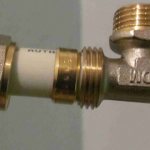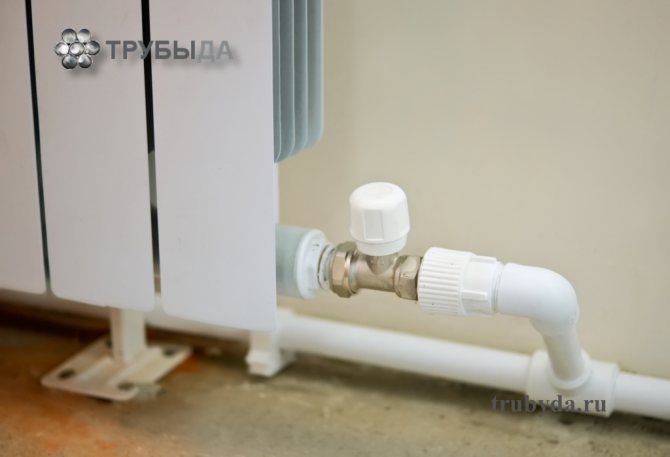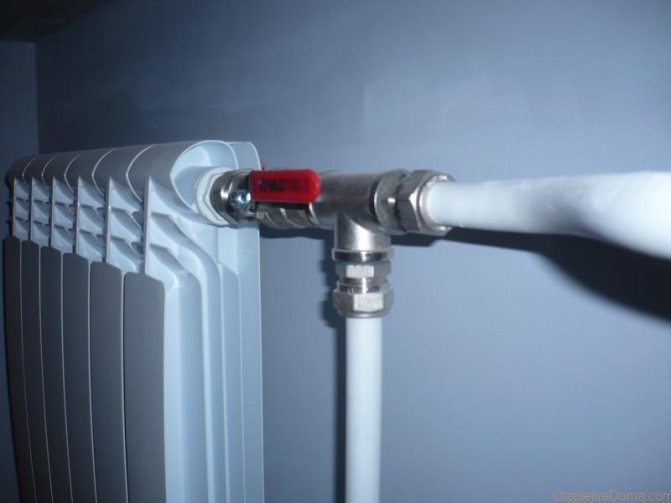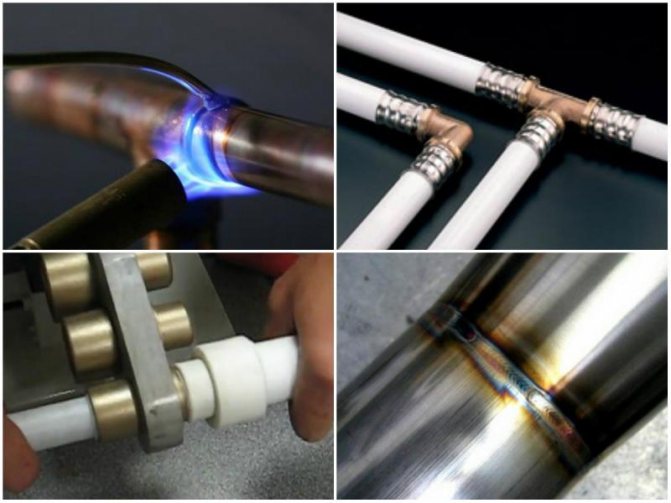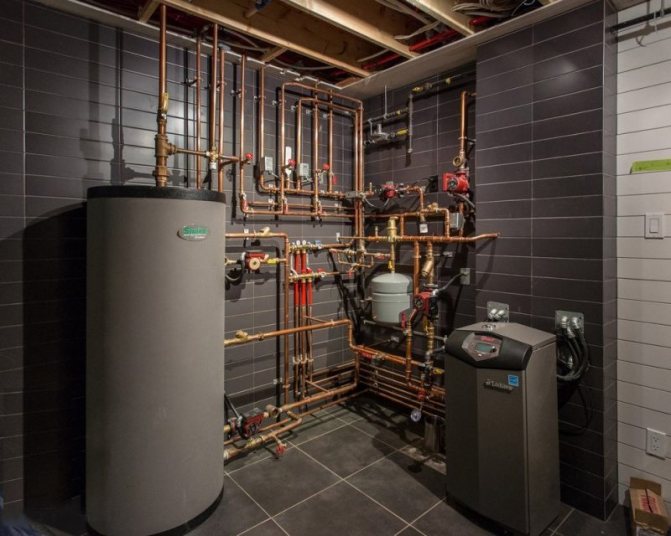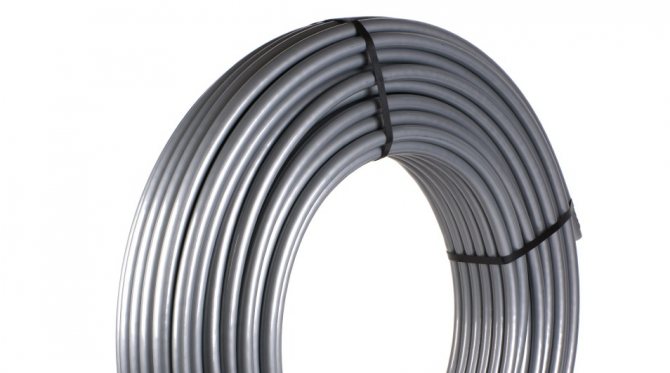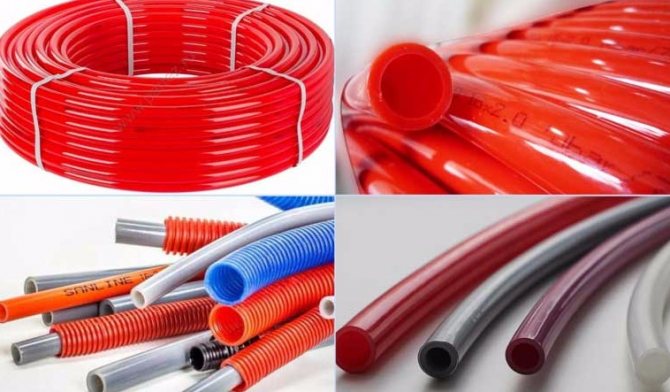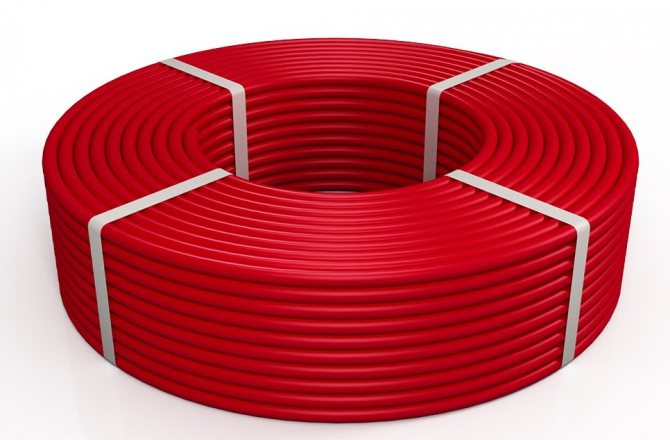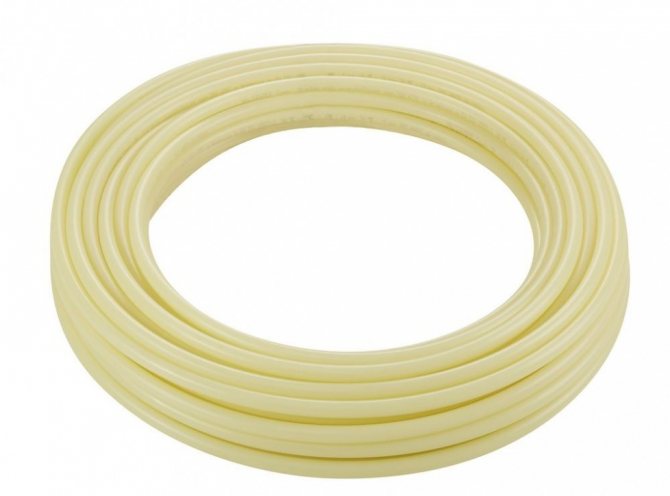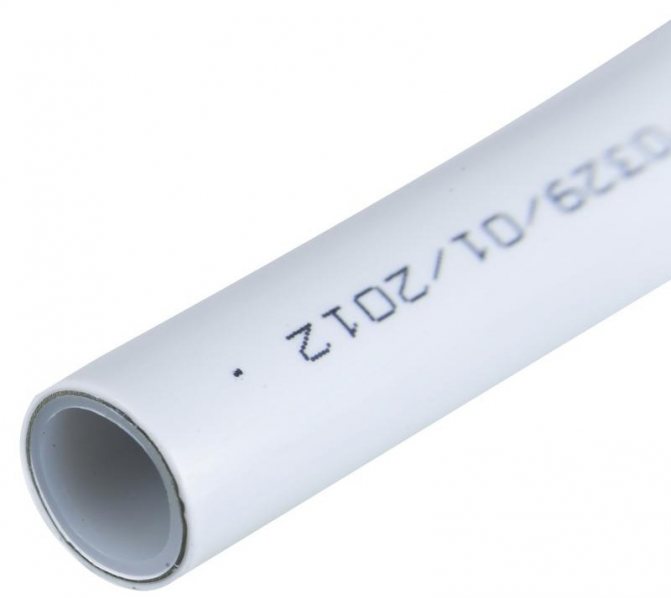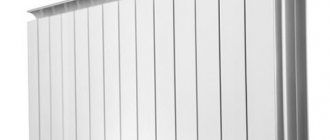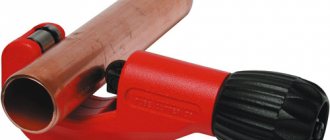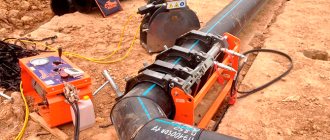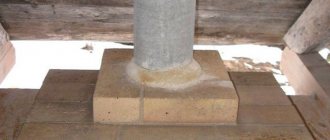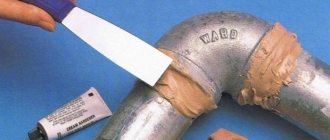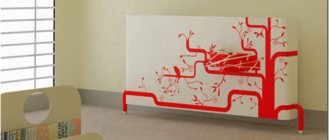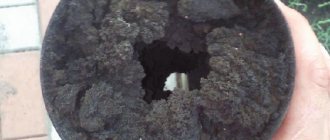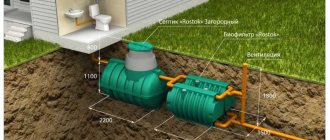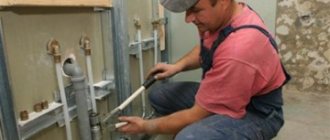Connection types
Modern communications can be assembled from metal, plastic, metal-plastic, pvc, HDPE and other pipes. The material of manufacture determines the choice of the method of connecting the risers into a single structure. Therefore, the elements of the pipeline system can be collapsible and non-collapsible types.
Among the many detachable joints, both threaded and non-threaded connections are equally popular. Threaded methods include connections using:
- squeegee, couplings, lock nuts;
- American women with a union nut;
- bi-directional threads.
The threadless method includes articulation using:
- flanges;
- welding;
- compression fittings.
and other devices, depending on the pipe material.
We will discuss these types of connections in more detail later.
Heating system connection
The industry produces pipes from a variety of materials. These products are used for laying water pipes, sewers, gas pipelines, and other pipeline communications.
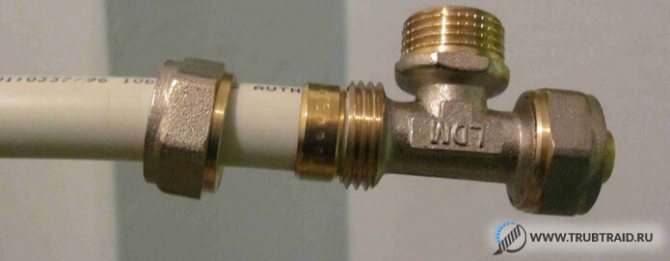
During the laying of heating systems, pipes are used from:
- become;
- copper;
- plastic.
Depending on this, the risers in heating structures can be connected using:
- welding;
- threaded fittings;
- flanges;
- press connections;
- compression and slide fittings,
- and other methods using innovative modern technologies.
Threaded copper pipes
Steel pipes have long dominated the installation of heating systems. Gradually, they began to be replaced by products from other materials.
Today is the time for copper and plastic pipes. They are connected using soldering, compression and press fittings. But the threaded connection in the heating system of metal pipes practically remains a priority among all types of joints.
Threaded connections are used not only when laying heating pipes, but also when fastening steel, including galvanized, water pipes.
In gas lines and especially in high-pressure pipelines, welding is used as a connection.
A joint using threaded fittings is characterized by:
- fast assembly;
- high quality, reliable connections;
- the ability to install in hard-to-reach places.
Important! Using a threaded coupling, squeegees, locknuts, elbows, cranes, you can not only quickly dismantle, but also assemble the pipeline.
Without the presence of fittings with internal and external threads, it is impossible to qualitatively mount a pipeline from copper risers. To install these parts of the system, it is necessary to have threads not only on the connecting elements, but also on the ends of the risers. All measuring devices are connected using fittings.
When installing copper pipes, an American woman is often used, which is rightly considered one of the types of threaded connections.
Important! When using copper pipes for hydraulic systems, remember that copper does not mix well with other metals and alloys, since upon contact a chemical reaction occurs that can destroy the elements of the heating circuit.
Threaded
It is used in cases where the diameter of the parts to be joined does not exceed 40mm. In this method, docking takes place using a special device. One end of this device is metal with a thread applied to it. A metal pipe is screwed to it. The other end is plastic. Plastic is connected to it, using a union nut, or soldering.
The connecting devices are divided into three types:
- American
The most popular option. "American" is a special element consisting of a metal part with an applied (internal or external) thread and a plastic pipe.
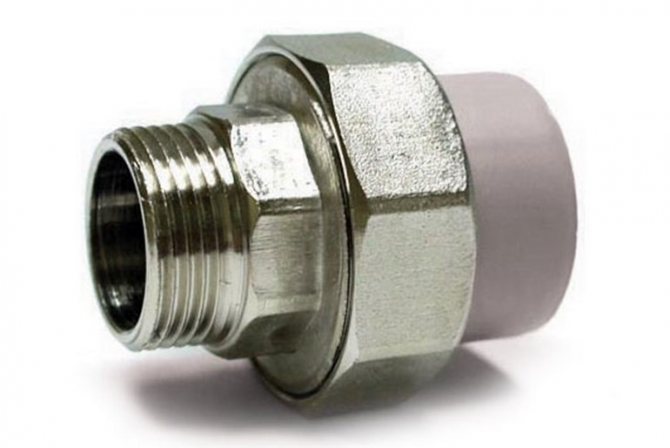

The connection of the metal pipe with the "American" is made by screwing a special union nut onto the thread, on the other hand, using a special soldering iron, the plastic part is welded. The sealing is ensured by the installation of a rubber gasket.
The advantage of this adapter is its detachability. The pipes can be disconnected if necessary. When unscrewing the metal part, it is important not to damage the rubber gasket.
- Fitting-nipple
It is a plastic sleeve with a threaded metal plate welded inside.
One part of the fitting-nipple is screwed onto the external thread of the connected iron pipe, the second part is soldered to the polypropylene product. It is imperative to use a sealant, such as FUM tape.
- Metal hose
The metal hose is a flexible hose with sealing cuffs and union nuts. The diameter is different.
Docking with a metal hose is the most uncommon option. But, when it is necessary to fasten parts that are distant from each other, this method is optimal. The metal pipe is screwed to one of the parts of the metal hose, and a nipple fitting is used to attach the plastic pipe. When choosing a sleeve and a nipple fitting, you should pay attention to the thread of the products.
Flanged
In the case when the pipe diameter is more than 40mm, it is convenient to use flanges for connection.
In this case, the flange must be plastic (metal will not work) with additional sleeves with collars and limiting flanges. If a flange is already present on a metal part, it is necessary to choose a plastic one according to its size.
A sleeve with a collar is put on the ends of the elements to be connected, the flanges abut against the collar. Sealing is achieved by using rubber or paronite gaskets. The collars of the bushings can be straight and tapered (in the figure above, the tapered collar). The flanges are attached with bolts or studs. Fasteners are tightened crosswise, without compressive force.
Fitting
Gebo fittings are gaining popularity.
Gebo fitting is a ferrule in the form of a pipe. The Gebo fitting includes several rings - clamping, clamping, sealing and union nut. Each of the elements has a pair and they are located at both ends of the coupling. This connection option is used if it is impossible to apply a thread to the metal.
Connection sequence:
- The fitting is untwisted;
- All clamping rings are put on the connected products;
- A coupling is connected to one of the pipes, tightened by means of a union nut;
- The same thing happens with the other pipe.
This connection ensures 100% tightness of the joint, but the fitting itself must not be loaded.
Threadless
Compression connection.
The clutch consists of the following parts:
- High strength steel or cast iron body;
- Two brass or bronze nuts located on both ends of the body;
- Four metal washers installed in the inner cavity of the body;
- Sealing rubber gaskets.
Metal and plastic pipes are inserted into the coupling each to the middle, until they touch. The nuts are tightened to the stop.
There is another way of threadless connection. For this, a metal hose is used. The hose is put on the edges of the parts to be joined and crimped with special clamps. Now on the market you can find rubber bushings that work in this way.
There is also a completely "barbaric" way of connecting a polymer pipe with a metal thread without using any fittings. By the way, this method is shown in the video below. Here the plastic pipe is heated from the inside with a special "iron" and then screwed onto a metal thread. The hot plastic wraps around the metal and creates a fairly strong bond.
But personally, I think this method is absolutely unreliable and I do not recommend using it in intra-apartment communications.
Gas
For decades, gas lines have been assembled from seamless metal pipes. Under the influence of corrosion, their service life is significantly reduced. This factor was one of the reasons for the replacement of metal pipes on products made of other materials
:
- polyethylene;
- copper;
- of stainless steel.
Each type of pipe can be joined in different ways. Is it possible to connect gas pipes with a threaded connection
and if so, what materials are the risers threaded with? Yes, you can. For example, steel and copper products are connected using a thread.
When joining gas pipes, the threadless method is also used.
In particular:
- brazing can be good for joining copper or polyethylene parts of the pipeline;
- welding is successfully used when laying steel, copper lines. For example, steel elements can be autogenous or arc welded;
- with the use of flange fasteners, the installation of main pipelines takes place. In addition, flanges are installed at those points of the pipeline system where the branch from the main gas pipeline to the house or apartment is located.
Metal
Gas, water, steam, household wastewater, and other working media are transported through metal pipelines.
During the laying of individual sections, one-piece connections are used:
- welding;
- thread;
- soldering.
Detachable joints include
flanges, squeegees, union nuts. They are used on systems that are frequently dismantled.
Metal risers are used when laying water and gas pipelines. To join with a thread, you must use a squeegee, coupling, locknut.
Copper pipes are connected by soldering. Such joints are highly reliable.
Both threadless pipe connections and threaded ones are collapsible and non-collapsible types.
How can a threaded device be non-separable, you say?
Yes maybe. There are situations when 2 pipes are threaded and then welded to fixed structures. This is an example of a one-piece thread fastening.
Threaded coupling
An interesting type of joint was the docking using bi-directional thread
... Such a connection is carried out by a threaded coupling while screwing it onto both risers, if the pipes to be connected have multidirectional threads. Therefore, before making a threaded connection of such pipes, you must once again make sure that there are different directions of the thread on the risers.
The main thing is to choose a good sealant. Silicone can be sealed. Although many people use the old proven method, using FUM tape or sealing thread and oil paint.
Copper pipe joining options
When assembling heating, various installation methods are used. So, the joining of copper pipes is made by a collapsible and non-collapsible method. In the first case, flanges, threaded fasteners, fittings that fix automatically are used. When designing a non-separable heating system, they resort to pressing, soldering and welding.
Welding butt
Let's take a look at the process of welding copper pipes. This method of joining is applied to pipes with a diameter of 108 mm. The wall thickness of the heating material must be at least 1.5 mm.Welding, in this case, only needs to be butt welded, while the proper temperature should be 1084 degrees. It should be added that this option for installing heating is not recommended to be done by hand.
Today, builders use several types of welding:
- Gas welding using oxygen-acetylene torches.
- Welding with consumable electrodes, carried out in an inert gas environment - argon or helium.
- Welding using non-consumable electrodes.
In most cases, the arc welding method is used to join copper elements. If the pipes that are planned to be used for assembling the pipeline are made of pure copper, then here it is necessary to use infusible tungsten electrodes in an argon, nitrogen or helium environment. When welding copper elements, the process must be fast. This will prevent the formation of various oxidations on the metal base of the pipe.
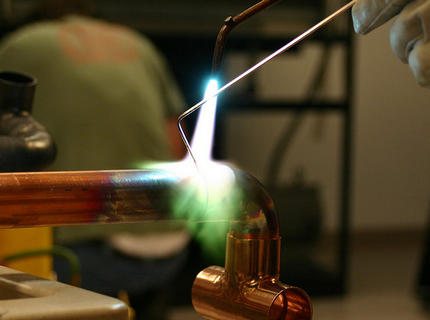

Welding connection of copper pipes
To give strength to such a joint, upon completion of the joining work, it is recommended to carry out additional forging of the resulting joints.
Flare connection
It happens that the use of welding torches when installing heating systems creates some inconvenience. In this case, it is recommended to resort to flaring the copper pipe connections. This installation method will turn out to be detachable, which will play a positive role in the event of a forced assembly of heating.
An operation of this kind will require the mandatory presence of a flaring device. We will try to describe in detail below how to connect heating pipes by flaring:
- for a start, the tip of the pipe is cleaned in order to remove from its surface the scuffs and burrs formed when cutting the material;
- a coupling is fixed on the pipe;
- then the pipe is inserted into the clamping device, with the help of which further flaring is performed;
- then you should begin to tighten the screw of the tool until the angle of the end of the pipe reaches 45 degrees;
- after the pipe area is ready for connection, the sleeve should be brought to it and the nuts tightened.
You can learn more about the process from the video presented.
Pressing connection method
In addition to all of the above methods of installing heating pipes, there is also a pressing method. To join the copper elements, in this case, it is necessary to insert the previously prepared end of the pipe into the coupling until it stops. After this, you will need to use a hydraulic or manual press, through which the pipes will be fixed.
If the heating is planned to be assembled from thick-walled pipes, press fittings with special crimp sleeves are required. These elements make it possible to crimp pipes and fittings for heating from the inside, while external seals will give an excellent tightness of the structure.
Galvanized
Zinc is one of those metals that do not corrode. Therefore, you cannot imagine the best protection for steel pipes from moisture.
The galvanizing process involves covering the inside and outside of the riser with zinc. The service life of such a pipeline is determined by the quality of the coating and the thickness of the applied metal layer.
Galvanized risers are connected by thread or welding. Many people believe that galvanized pipes are generally prohibited to be used for laying water pipes. But this is not the case. The fact is that such risers are not recommended for transporting hot water.
But the use of products to supply cold water at home does not pose any danger to the human body. The main thing is that the drinking pipeline is used constantly, and the water does not stagnate in the pipes.Then, in such a liquid, the presence of zinc will be about 5 mg / l, which is lower than the maximum permissible concentration per day (the norm is 12-15 mg / l).
Important! The degree of zinc concentration can be determined independently: if the indicators of the presence of zinc are increased, then the water has an astringent taste.
Galvanized riser
Galvanized risers are used for laying an autonomous water supply system. With their help, wells are equipped, although GOST does not foresee the use of such risers as a casing.
The fact is that the water exchange in the well is small, which does not exclude the possibility of a deterioration in the chemical composition of the water. Plus, under the influence of the soil environment, if the joints are not reliably sealed, electrochemical corrosion is possible.
Therefore, on the question of whether it is necessary to seal the threaded connection of the casing
the answer is unequivocal: yes, you need to.
In the case of making up the joint, use thread sealants. The highest quality seals are of the RUSMA series, which reliably seal and protect threaded connections.
Types of pipe seals
From a wide variety of materials intended for sealing threads, the following can be distinguished:
Many users use flax to seal plumbing threads. This material is suitable for all metal parts: cast iron, steel, brass.
It is not recommended to use linen for plastic fittings and fittings made of metal and plastic. The thing is that the sealing of pipe connections with flax initially presupposes a high-quality seal. To do this, you need to make an effort and tighten it well.
The plastic parts will be very difficult to tighten. Rather, it will be possible to simply rip off the thread, rather than create an airtight connection with the flax gasket.
Plumbing thread
Plumbing thread is a good sealant, which is of high quality and excellent strength. It can be used to seal pipe connections made of metal, plastic, metal-plastic.
Its only drawback is its high cost compared to other types of seals. And the rest is a reliable sealant.
Sanitary thread Henkel Tangit Uni-lok
Adhesive sealant
The adhesive is suitable for almost any threaded connection. In the process of working with this material, it is important to observe one condition - before applying it to the surfaces of parts, they must be well degreased.
With regards to products made of steel, this condition can become a serious obstacle to the use of a sealant. This is due to the fact that threading is usually carried out directly at the installation site. To improve the performance of the tool, special lubricants are used. But it is very difficult to remove them from the metal surface in a working environment, and sometimes it is not possible to do this at all.
If you neglect this requirement and apply an anaerobic sealant to the oil-contaminated steel surface, you will get an unreliable connection that deforms very quickly.
Another limitation in the use of thread glue is the way it is removed. The fact is that in the process of dismantling the joints with the sealant, it is necessary to heat the parts. This procedure is not terrible for metal products, but products made of plastic or metal-plastic can be damaged.
It should be said that heating of parts during dismantling is provided only for certain types of sealant. Therefore, you need to carefully read the information provided on the product packaging.
Thus, the sealant can be used for any threaded connections, with the exception of steel products. When choosing a sealant, you need to take into account the fact that sooner or later the parts will have to be dismantled, therefore, for plastic and metal-plastic products, it is worth choosing an adhesive that does not require preliminary heating of the parts for application.
Anaerobic sealant glue Fixant enkor
This sealing material has been used relatively recently compared to other sealants. Builds a fum tape - inexpensive, but it cannot boast of high durability, tk. material tears with little effort.
According to manufacturers, fum tape is an excellent sealant, but as practice shows, the quality of the joints leaves much to be desired.
When choosing a threaded joint seal in an apartment or house, it is better to abandon the idea of using fum tape and give preference to more reliable sealants. And for example, at a summer cottage, in the garden, fum tape can be used. There are no such stringent requirements in terms of reliability and durability.
Reinforced plastic
Old metal pipes that have served for a long time are usually replaced with metal-plastic ones. This replacement is due to the presence of a number of positive characteristics that metal-plastic has in comparison with other materials.
It differs in:
- long service life;
- ease of installation;
- reliability and durability;
- low cost;
- the ability to operate in a wide temperature range: from -8⁰C to + 95⁰C, which makes it possible to use it for heating systems.
Reinforced-plastic risers can be articulated:
- using compression fittings;
- using press fittings.
Before performing the docking, it is necessary to complete a drawing of the placement of risers, plumbing devices, and control devices.
Then you need to make accurate measurements and cut off the necessary pieces of the pipe, spread them along the future pipeline. So that no burrs and roughness remain on the ends, clean the ends with a sharpened drill or round file. Align the deformed edges with a sizing tool and the pipe is ready for installation.
Pvc
Statistics say that during the repair of engineering networks, about 75% of old risers are replaced with PVC (polyvinyl chloride) pipes. The laying of new communications is also most often carried out using pvc risers. Why is their popularity soaring?
The fact is that:
- the installation of the highway can be done by hand. This fact favorably distinguishes risers from similar products from other materials;
- their cost is quite budgetary, which helps to save significant funds;
- products are durable and reliable;
- structures are resistant to corrosion processes, which contributes to a long service life.
You can dock pvc pipes using:
- sockets. In this way, sewer risers are connected, and rubber rings act as a seal. They can be lubricated with anaerobic sealant, which will greatly enhance the sealing process;
- flanges. Such fastening is indispensable in the presence of pipelines that are being disassembled, associated with frequent periodic preventive maintenance. This applies to the mains of the temporary type, to the pipelines that are often moved;
- thermistor type welding, which is used when joining pipes with diameters of 20 mm and more. In addition, cold welding (adhesive bonding) is often used. The procedure is carried out using a special glue, which should be applied with a brush to the entire length of the inner surface of the fitting and around the circumference of the pipe.
Important! Before cold welding, it is necessary to chamfer the ends of the glued risers at an angle of 15 degrees. To carry out the procedure, use chamfering incisors.
Polypropylene
Risers with a diameter of less than 63 mm are fastened using socket or socket welding. For this, an additional element is used - a clutch. For threaded or other joining of risers, fittings with sockets are used.
In the case of articulation of risers 63 mm in diameter and above, butt welding is used. If appropriate fittings are available, socket welding can be used. When it is necessary for the fastening to be collapsible, flanges are used.
With the help of a special welding machine and attachments to it, you can reliably and quickly connect polypropylene or polyethylene pipes.Using such a device, they fasten the risers with a diameter of 16-40 mm. To cover the nozzles, non-stick typhlon is used, which makes it possible to carry out the docking of the highest quality.
Plastic
Electrofusion welding
Docking of plastic pipes is carried out using:
- diffusion welding;
- carving;
- flanges;
- glue;
- fittings;
- electrofusion welding.
When installing a sewage system from plastic pipes, they can be connected into a socket. The connection is quite effective when used in low pressure pipelines, such as the above sewerage system.
An excellent option for bonding plastic pipes is cold welding. The essence of its effect on connecting risers is that the glue dissolves the upper part of the plastic of the pipe, thus ensuring the adhesion of the risers at the molecular level. Simple, high quality, reliable.
An effective and relatively inexpensive way of joining plastic pipes is a fitting connection. If you need to fasten plastic pipes with metal ones, then the easiest way to do this is using a fitting joint.
For collet fastening, crimp-type fittings are used. At the same time, the joint is formed in the place where the teeth of the metal riser cut into the line element.
Methods for connecting metal pipes with plastic
There are two ways to connect plastic pipes to metal pipes, which are used for steel pipelines.
- Threaded joint used in cases where the diameter of the pipes to be connected does not exceed 40 mm.
- Flange connections optimal for large diameters, since it is difficult to tighten the thread in such cases.
Features of threaded connections
In order to understand how to connect a plastic pipe with a metal pipe using a thread, you should study the fittings used for this purpose. They are adapters, on one side of which there is a thread for connecting a metal pipeline and a smooth coupling for soldering plastic pipes on the other. There are also models for connecting more dissimilar lines, as well as fittings for making turns and bends.
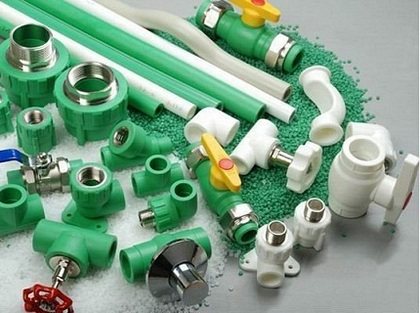

Polypropylene threaded fittings for PP to metal conversion
The threaded connection of steel and plastic (polypropylene) pipes is performed in a specific sequence.
- The junction is being prepared from the side of the existing metal communications. If there was already a threaded connection in this place, it is untwisted. If the pipes were welded or the place of installation of the plastic insert is the middle of a whole steel pipe, the latter is cut, after which grease is applied to the edge and the thread is made using a thread cutter.
- The threaded end of the steel pipe is cleaned and a sealing material is applied to it: tow or fum tape with silicone grease. In order to eliminate the likelihood of leaks, it is important to properly seal - to lay no more than 1-2 winding turns with the direction along the thread.
- The threaded end of the fitting is connected to a metal thread. In this case, one should not only not use special tools, but also do not over-tighten the connection by hand. Significant force can lead to cracking of the fittings. It will not be difficult to tighten the threads additionally if, after installation, during the test filling of the system, a leak is detected.
- After completing work with the threaded part of the connection, a plastic pipe is fixed on the smooth sleeve of the fitting by welding.
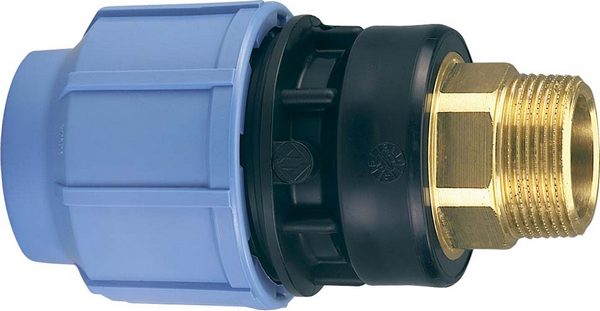

A fitting for polyethylene pipes (HDPE) at one end has a thread for connection to metal, and at the other end a compression fixture for a HDPE pipe - unlike polypropylene pipes, welding is not required here
Making flange connections
The connection of a plastic pipe with a metal pipe without a thread is performed using flanges. Its advantage is the ease of dismantling for repair or cleaning of communications.
Flanges of various types are used as connecting elements for detachable connections of dissimilar pipelines.
- Lightweight structures with a diameter not exceeding 300 mm, as well as medium and heavy pipes up to 150 mm, are connected using free flanges, with a straight shoulder for support. Such modifications are most common when installing communications in private households and high-rise apartments.
- For pipes of any type with a diameter of up to 200 mm, loose flanges with a tapered shoulder can be used.
- A shaped flange and a steel shoulder using a wedge-type connection is a universal option.
- Maximum strength can be achieved with a straight tapered shoulder.
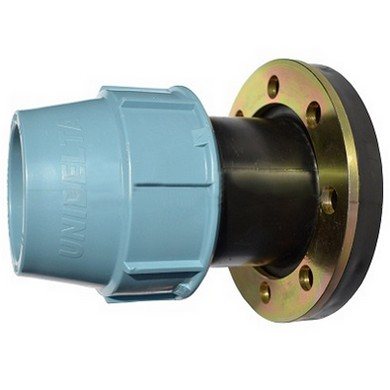

Flange connection for HDPE pipes
As a preparatory work before installing the flange connection, it is important to carefully inspect the prepared flanges. On them there should be no burrswhich, when installed, may damage the plastic part of the connection. In most cases, these burrs are easy enough to remove.
The assembly procedure for a flanged assembly is as follows:
Mounting a plastic pipe to a metal pipe using flanges
- The steel pipe is cut at the point of the intended tie-in. In this case, it is important to make the cutting line evenly and accurately.
- The flange is pushed onto the pipe.
- For the tightness of the connection, a rubber gasket is installed, the size of which must be such that it does not go beyond the cut line by more than 10 mm.
- The main elements of the assembly are connected - the flange put on the pipe is aligned with the gasket and fastened to the second flange using bolts.
Tightening should be done by evenly screwing the thread of the fastener around the entire circumference and avoiding unnecessary efforts.
If you are interested in what is better to make a suburban water supply, we recommend that you read our article "Plastic pipes for water supply in the country". Types and tips for installation.
The easiest way to install HDPE pipes is to use fittings. We have another article about compression fittings for polyethylene pipes.
If you need to choose a press jaw for installing metal-plastic pipes, then here you will find useful information.
Drilling and high pressure pipelines
With drill pipes:
- lift the rock cutting tool;
- rotation is transmitted;
- there is a transfer of axial loads to the tool;
- flushing liquid is supplied.
Therefore, the load on such a structure is quite large. The connection of the drilling risers is carried out with drill joints, which have a special tool joint thread.
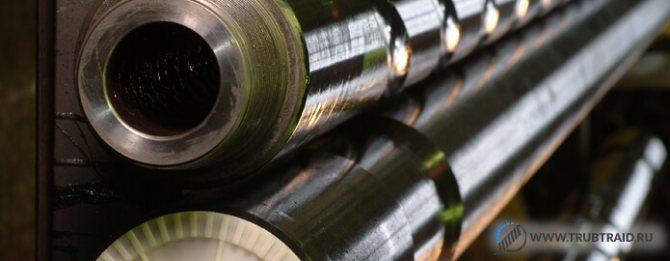

To make the structure more durable and operate for a long time, a consistent anti-corrosion grease is used to protect the locking threads. Also, the thread is protected by applying metal safety elements to the connecting points.
One of the most complex technological operations is the design and installation of high-pressure pipelines. The specificity of the functioning does not allow for the possibility of interruptions in the operation of the pipeline. Otherwise, an emergency situation may arise. Therefore, there must be reliable fastening of the risers using a high-quality seal of threaded connections.
High pressure pipelines can transport gas, steam, liquids over long distances. The pressure in the transport system can reach 25 atm and higher.
For laying pipelines, pipes made of steel (carbon and alloyed), copper, plastic (mainly polyethylene) are used. Fastening of pipes to each other can be split and one-piece types.
Important! When installing a high-pressure pipeline, you need to strive for a minimum number of split-type connections. This is due to the need for increased safety when transporting the working environment.
Sufficiently reliable fasteners of the one-piece type are rightfully considered:
- seam welding;
- fusion welding;
- soldering.
Methods for connecting pipes of the heating system
Quite often, when installing the system, several types of connections are used, some are intended for closed sections, others can be used in open pipelines.
There are three main ways:
- press fitting;
- compression;
- welding.
Press fitting
Installation of a press fitting is as simple as possible, but requires special equipment. The part consists of a sleeve and a sleeve. One of the advantages of the connection is the absence of an O-ring, as in the compression version. With the help of the tool, the pipe is expanded to a size that allows insertion of the sleeve, then the sleeve is pulled over it. Over time, fitting elements wear out and need to be replaced.
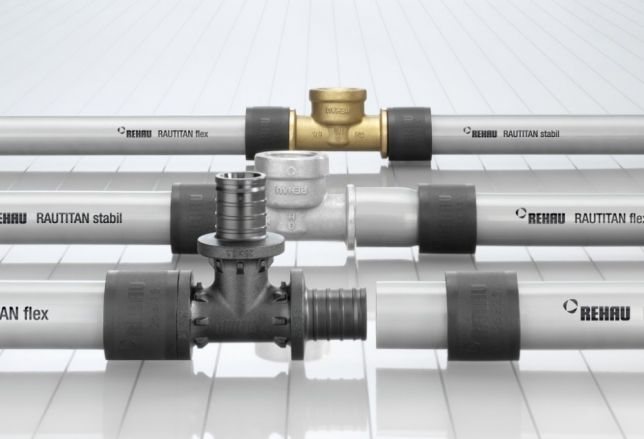

Compression fitting
A compression fitting consists of a sleeve, ferrule, nut, gasket, and seals. The connection is also pretty straightforward. The coupling socket is inserted into the pipe, a ring is placed on top, and then pressed with a nut.
For such a connection, it is sufficient to have two adjustable wrenches. Despite the fact that such a fitting requires quite frequent preventive inspection and replacement of seals, it is serviceable, that is, collapsible. It can be removed, replaced, used elsewhere at any time.
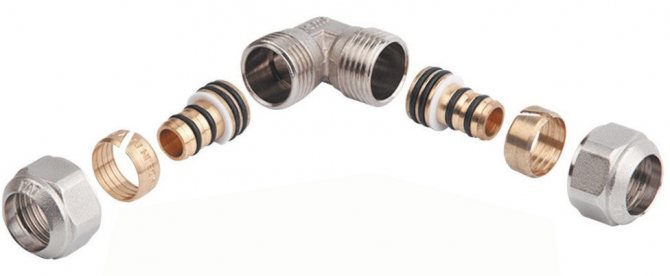

Electrofusion fitting
Welding in a domestic environment is used quite rarely, this is due to the fact that the equipment for such work is expensive, and the process itself requires high qualifications. The principle is as follows: metal elements are mounted in the polyethylene coupling, which heat up when current is passed through them and melt the required structural element of the coupling. When cooled, a reliable and durable seal is formed.
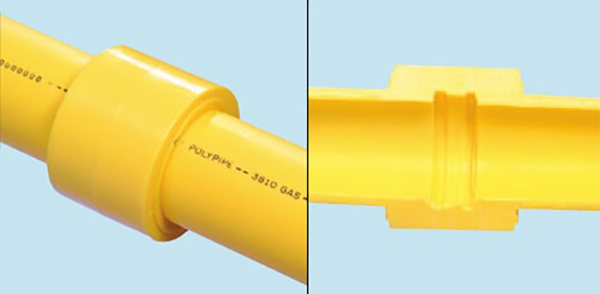

Thread Sealant and Sealing
In places where the elements of the pipeline are connected, liquid can flow, gas can escape. To protect yourself from such situations, the threaded joints of the pipes are sealed with a thread sealant. The tool may be different in appearance, but its purpose is the same - to seal the joints.
Teflon tape
Among the many sealing materials are:
- Teflon tape, which is the simplest sealant;
- mastic or red lead paint in combination with tow. This seal has been used for several decades, it is still relevant today;
- sealants containing special solvents.
Important! Choose a quality seal that will provide a reliable threaded connection, which is especially important when laying gas pipes.
A one-component paste is also used, with the help of which you can easily achieve a reliable seal not only of threaded, but also of other types of fasteners of fittings and risers.
Important! Work with this seal is accompanied by quick installation and maximum accuracy. The substance does not shrink and does not pollute the inner cavity of the risers.
The great advantage of the material in comparison with Teflon or tow, is that with the help of the paste, the minimum gaps or cracks in the system are ideally filled, which ensures absolute tightness. The same cannot be said about the Teflon tape, which can collapse under dynamic loads and contaminate the inner tube space.
Working with tow is accompanied by some inconveniences in the form of contamination of risers, floor. In addition, it has strong creep and shrinkage.
How to seal the joint with flax?
When sealing threaded connections, you need to be very careful.Accuracy is a guarantee that nothing will flow. When working, you will need a special paste, which you cannot do without. It can be applied directly to the threads or to already wound flax.
The paste gets your hands dirty. It is not very pleasant to wipe them off. Therefore, there is a life hack - the installer first sits down, winds the flax onto the threaded connection, checks the quality of the winding (everything should be even) and then uses the paste, making a dozen connections at once. The connection should be free of protruding hairs, the first two turns remain free, so that you can screw the sleeve onto the external thread without fear. And a bead or thickening forms towards the end of the thread.
All compaction takes place on the last two threads. They are not fully cut, smaller than the rest of the turns. They are sealed with gluing of the sealing material between the two parts.
Couplings
When repairing gas and water supply systems or laying new ones, the question arises: what is the best way to connect the risers and seal the joints that have appeared.
If we are talking about detachable connections, then it is best to dock the risers using couplings. They can be used both in the form of connecting parts and as adapters, if the linear dimensions, including the diameters of threaded pipe connections, are different.
Important! When choosing a fitting, remember that pipes and couplings must be made of the same material.
Couplings differ:
- reliability;
- availability and breadth of assortment;
- speed, ease of assembly and disassembly;
- low cost.
Depending on the types of risers, similar connecting fittings are produced. The sealant is selected in the same way. If metal fittings are most often sealed with tow with oil paint, then FUM tape and a synthetic sealant, in particular an anaerobic sealant, are best suited for plastic parts.
Possible radiator connection diagrams
The most efficient battery connection is quite easy to accomplish - both in terms of the number of nodes and in terms of installation technology.
Two-pipe classic wiring
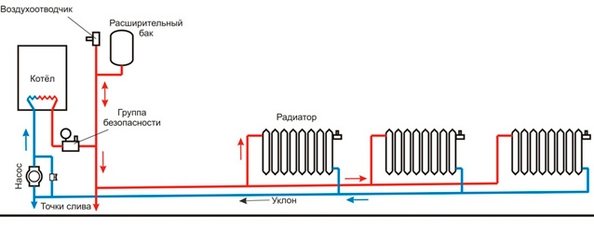

Classic two-pipe wiring diagram for the heating system.
In the classical scheme, the direction of movement of the coolant in the supply pipeline is opposite to that in the return pipeline. This scheme is most common in modern heating systems, both in high-rise buildings and in private individual ones. The two-pipe scheme allows you to evenly distribute the coolant between radiators without temperature loss and effectively regulate heat transfer in each room, including automatically by using thermostatic valves with installed thermal heads.
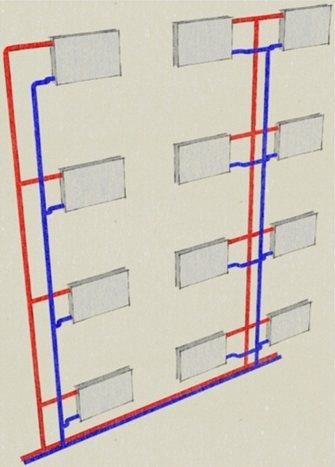

Such a device has a two-pipe heating system in a multi-storey building.
A passing scheme or "Tichelman's loop"
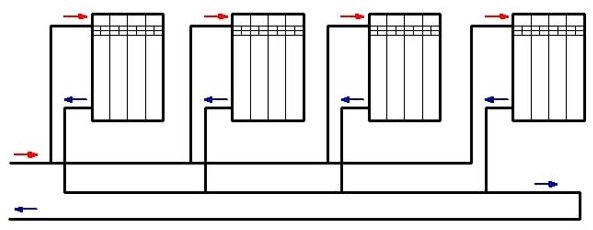

Accompanying heating wiring diagram.
The passing scheme is a variation of the classic scheme with the difference that the direction of movement of the coolant in the supply and return is the same. This scheme is used in heating systems with long and remote branches. The use of a passing circuit allows you to reduce the hydraulic resistance of the branch and evenly distribute the coolant over all radiators.
Fan (beam)
A fan or beam scheme is used in multi-storey construction for apartment heating with the possibility of installing a heat meter (heat meter) on each apartment and in private housing construction in systems with floor-by-floor piping. With a fan pattern in a multi-storey building, a collector is installed on each floor with a separate pipeline exits to all apartments and an installed heat meter. This allows each apartment owner to take into account and pay only for the consumed heat.
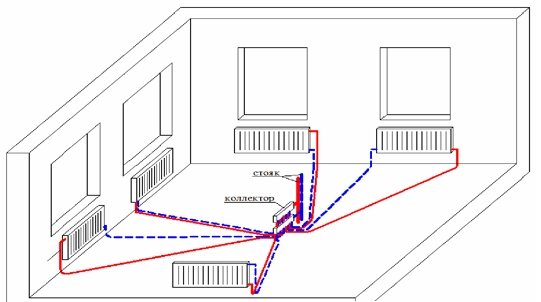

Fan or radial heating system.
In a private house, a fan circuit is used for floor-by-floor distribution of pipelines and for radial connection of each radiator to a common collector, that is, a separate supply and return pipe from the collector is similar to each radiator. This method of connection allows the coolant to be distributed as evenly as possible over the radiators and to reduce hydraulic losses of all elements of the heating system.
Note! With fan-shaped piping within one floor, installation is carried out in one-piece (without breaks and branches) pipe sections. When using polymer multilayer or copper pipes, all pipelines can be poured into a concrete screed, thereby reducing the likelihood of rupture or leakage at the joints of the network elements.
Which scheme to choose
From everything that we have described above, we can conclude that the Tichelman scheme is the simplest, most flexible and effective. The use of two double collectors can become a kind of alternative - the efficiency of liquid distribution in such a scheme is quite high, however, there are some difficulties during installation; in addition, further adjustment will be required.

